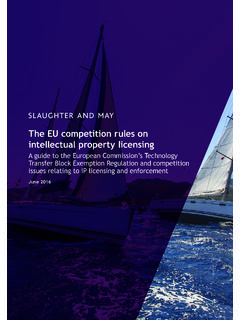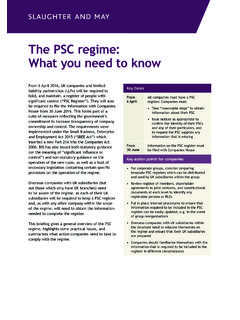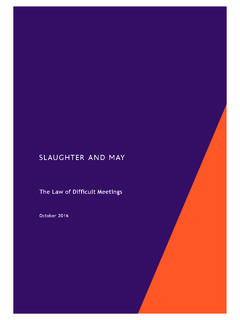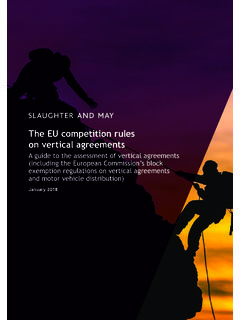Transcription of Processing of personal data: consent and legitimate ...
1 Processing of personal data : consent and legitimate interests under the GDPRThe General data Protection Regulation (GDPR) introduces a wide range of reforms to the European data protection regime which will continue to be relevant for many companies regardless of the UK s future relationship with the EU. The GDPR introduces a number of changes to the concept of consent as a condition to lawful Processing , as well as updating and revising the general principles of Processing and the legitimate interests condition. Many of these changes formalise current best practice and this briefing explores what has changed and the implications for those who rely on these conditions to operate their for lawful Processing under the GDPRAs is the case under the data Protection Act (DPA), the Processing of personal data must fall within one of six specified conditions.
2 The differences in the commonly used consent and legitimate purpose conditions under the GDPR are shown ConditionThe data subject has given his consent to the processingThe individual has given consent to the Processing of his or her personal data for one or more specific purposesLegitimate Purpose ConditionThe Processing is necessary for the purposes of legitimate interests pursued by the data controller or by the third party or parties to whom the data are disclosed, except where the Processing is unwarranted in any particular case by reason of prejudice to the rights and freedoms or legitimate interests of the data subjectProcessing is necessary for the purposes of the legitimate interests pursued by the controller or by a third party, except where such interests are overridden by the interests or fundamental rights and freedoms of the data subject which require protection of personal data , in particular where the data subject is a child.
3 This shall not apply to Processing carried out by public authorities in the performance of their tasksProcessing of personal data : consent and legitimate interests under the GDPR2 Meaning of consentThe concept of consent in the GDPR is stricter than in the DPA, setting out more onerous requirements in relation to both the content of consent and the way in which it should be obtained. Where Processing is based on consent , companies must be able to demonstrate that consent was given by the individual to the Processing of the personal data . The GDPR defines consent as:any freely given, specific, informed and unambiguous indication of his or her wishes by which the data subject, either by a statement or by a clear affirmative action, signifies agreement to personal data relating to them being processed.(Emphasis added)Taking each of these concepts in turn: consent must be freely givenAs currently, individuals should have a genuine and free choice as to whether or not to consent to the Processing and should be able to refuse or withdraw such consent without detriment.
4 However, the GDPR provides that consent will not be freely given where the performance of a contract, including the provision of a service, is conditional on consent to the Processing of data that is not necessary for the performance of the relevant raises a question over the legitimacy of the many free digital services which are offered on the condition that users agree to receive marketing information. A strict reading of the GDPR suggests that individuals consent cannot be relied upon in these circumstances because the details are not necessary for the performance of the service and, therefore, the consent is not freely given. The Article 29 Working Party s (A29WP) previous guidance on consent under the data Protection Directive (Directive) supports this interpretation. In that guidance, the A29WP considers whether a social network service could require users to consent to certain Processing as a condition to providing the service.
5 The A29WP concluded that users should be put in a position to give free and specific consent to any Processing which goes beyond what is necessary to deliver the given consent in an employment contextThe extent to which consent can be relied upon in the employment context to justify the Processing of personal data is already doubtful under the DPA regime, as reflected in both the ICO s and the A29WP s guidance. Unsurprisingly, this position will remain the same under the GDPR: it is clear that consent will not be an appropriate ground where there is a clear imbalance between the data subject and the controller . This will not always be the case in an employment context (see the intranet example below) but, in general, Processing by employers will need to be carried out under a different similar point is made by the A29WP in its July 2016 opinion on the ePrivacy Directive, which considers how the directive should be revised to ensure it is future must be specific and informedThese requirements were present in the EU data Protective Directive (Directive), which the DPA implements.
6 However, the GDPR clarifies that consent can only be informed if the individual is aware at least of the identity of the company which is the data controller and the purposes of the Processing of his or her personal data . If the intended Processing covers multiple purposes, consent must be granted for all such purposes. Processing of personal data : consent and legitimate interests under the GDPR3 There should, therefore, be a specific choice as to which purpose the individual consents to, rather than there being an all-inclusive consent to data Processing for multiple in a written declarationUnlike currently, the GDPR requires that where consent is given as part of a written declaration which also concerns other matters, the request for consent should be clearly distinguishable from the other matters and be presented in an intelligible and easily accessible form.
7 It will be important, therefore, to ensure that a data subject s consent to Processing is not buried in standard terms and conditions but is instead set out separately from other the objective of unbundling is to provide individuals with greater control over their data , there is a potential tension with the requirements that information and communications relating to Processing be easily accessible and easy to understand. Companies which rely on consent for multiple Processing purposes will likely wish to adopt a cautious approach to the specific consent requirements, but communicating this to individuals in a way they can understand may not be a straightforward must be unambiguousUnder the GDPR, consent must be unambiguous , a concept which existed in the Directive but was not used in the DPA. The GDPR also requires the consent to be explicit in some circumstances which are broader than where this is currently required.
8 The appropriate standard was much discussed before the final text was arrived at, with the ICO noting that references in the text to both unambiguous consent and explicit consent could lead to confusion as to what type of consent was needed in a given context. Having these two standards begs the question of when is consent unambiguous but not explicit ? One way to understand the issue may be to refer to the A29WP s previous guidance on consent . The guidance frames unambiguous consent as that which leaves no doubt as to the individual s intention to deliver the consent . Nevertheless, unambiguous consent need not be express: it may be inferred from certain actions. We would suggest it is the ability for unambiguous consent to be inferred that distinguishes it from explicit of personal data : consent and legitimate interests under the GDPR4 The following table illustrates whether the consent in various scenarios would meet the requirements of unambiguous and/or explicit of consentUnambiguous?
9 Explicit?A customer contract includes a written declaration of the customer s consent to specified types of Processing (the request being clearly distinguishable from other matters in the contract)Ye sYe sAn online retailer offers customers the opportunity to opt-in to specified Processing through a tick-box during the order processYe sYe sAt an event sign-in, participants are informed that the organisers would like to use their registration details for specified types of profiling and are asked (verbally) whether they consent to such processingYes, consent may be given verbally. However, the organisers may wish to consider how the consent can be documented with greater certainty, particularly in light of the GDPR s accountability requirementsEmployees are informed that photographs will be being taken in a section of the building during a particular time and that such photos will be included on the company s intranet.
10 Employees, having been so informed, decide to go to the area in which photographs are being takenYes, consent may be inferred from employees actions in going to the areas of the building in which photographs are being taken during the relevant timesNo, whilst consent may be inferred from the employees actions, it cannot be said to be explicitA social media website requires users to provide certain personal data in order to participate on the site. The site contains a notice, accessible in the privacy section, indicating that, by using the site, users are consenting to their data being processed by third parties to deliver them marketing informationNo, the GDPR is clear that inactivity cannot constitute consent . This is consistent with the no doubt analysis: ongoing use of the site may indicate consent to the Processing , but may also mean users have not read the notice.












